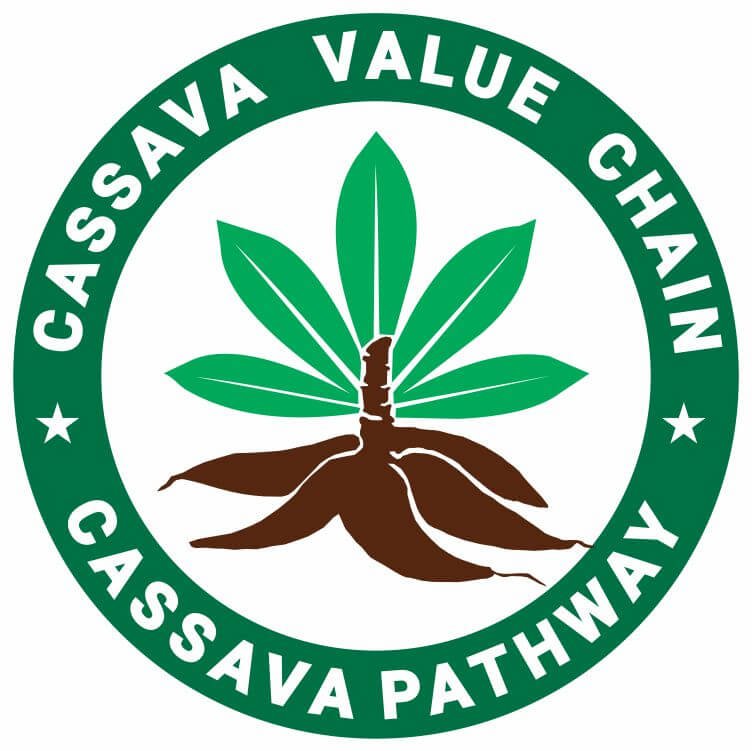This guide discusses cassava farming, focusing on the importance of harvesting at the right time. Learn about the growth stages of the supercrop, key visual and tactile signs it is ready to be harvested, and the consequences of late harvesting.
Every other month, we go to one of our small cassava farms, usually a little bit more than a plot, to harvest half of the cassava for subsistence use.
While I didn’t take notice of how long it took for them to mature, my mom knew when they were ready for harvest. Within three months, a particular farm would have been emptied, sustaining the family.
One of the key areas of cassava cultivation is identifying the right time for harvest.
Harvesting cassava roots at the optimal stage ensures the quality of the roots and affects overall agricultural productivity and food security.
When harvested too early, the roots may be small and starchy, while late harvesting can lead to over-mature tubers that reduce quality and become prone to pests and diseases.
Related: Soil Type for Cultivating Cassava
As cassava farming continues to expand in both smallholder and commercial agriculture, recognizing the signs cassava is ready to be harvested is important.
This knowledge helps ensure that you can achieve better yields and maintain the necessary standards for both local and international markets.
In regions where food security is a pressing concern, efficient cassava harvesting practices can add to alleviating hunger and supporting economic growth.
Table of Contents
- Understanding Cassava Growth Stages
- Visual Signs of Maturity / How Do You Know When Cassava is Ready to Harvest?
- Tactile Signs Cassava is Ready to Be Harvested
- Timing for Harvesting
- Consequences of Late Harvesting
- Conclusion
Understanding Cassava Growth Stages
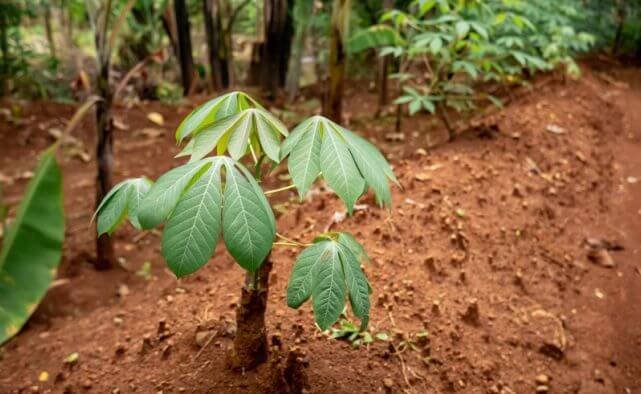
During the planting season as a kid, I would be delighted to see the shoots of the planted cassava stems appear with grace and tenderness.
It was always a delight to come every other day to try to figure out how they had added in height. Usually, you can’t see the shoot move, but in a few days, you see the change in height.
Generally, the growth cycle of cassava ranges from 6 to 12 months, depending on the variety, environmental conditions, and farming practices.
This duration is important, as it lays the groundwork for recognizing the signs of maturity in cassava plants.
Growth Stage
The growth stages of cassava can be categorized into four main phases:
- Establishment
- Vegetative growth
- Tuber bulking, and
- Maturity.
Establishment Stage: The establishment phase lasts approximately the first month after planting, during which the plant develops roots and foliage. During this period, adequate soil moisture and nutrient availability are vital for healthy growth.
Vegetative Stage: Following establishment is the vegetative growth stage, lasting from about one month to five months. At this phase, the cassava plant grows vigorously, producing leaves and stems. Proper sunlight and water are critical, as they directly influence the plant’s growth rate and overall health.
Tuber Bulking: Once the plants reach around five months, they enter the tuber bulking stage. In this phase, energy stored in foliage is directed towards the development of the tubers. This crucial stage can last up to six months when the tubers increase in size. Monitoring soil conditions and supporting the plant with nutrients is essential during this time to ensure optimal tuber development.
Maturity Stage: The maturity phase occurs between six to twelve months, depending on the specific variety and growth conditions. At this point, the leaves may begin to yellow, and the stems may harden, indicating that the cassava is approaching harvest.
Related: Bitter vs Sweet Cassava Roots
Visual Signs of Maturity / How Do You Know When Cassava is Ready to Harvest?
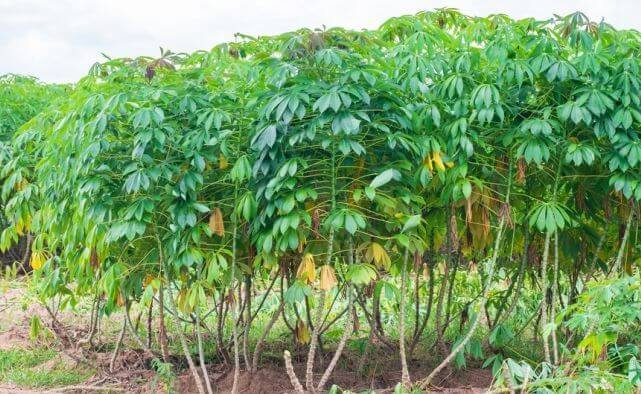
While a seasoned cassava farmer like my mother would know by a mere sight of the cassava farm, it could be difficult to tell a novice.
Recognizing the maturity of cassava plants helps for successful harvesting, as several key visual indicators can signal when the timing is optimal.
Changes in Leaf Colour
One of the first signs cassava is ready to be harvested is when the leaves change color. Mature cassava leaves tend to shift from a vibrant green to a darker shade, indicating that the plant is approaching the end of its growth cycle.
Also, as cassava matures, the leaves may become larger before eventually beginning to drop.
This leaf drop can be an indicator, serving as a visual sign your cassava is ready to be harvested.
Stem Condition
Another important aspect to consider is the condition of the stems. Mature cassava stems exhibit changes in size and thickness.
As the plants grow, the stems should become noticeably firmer and thicker, demonstrating that the cassava has developed well.
The color of the stems may also change, with mature stems often appearing more woody and robust. These physical signs are indicators of the overall health of the plant and its readiness for harvest.
Related: Storing Cassava Roots Correctly
Roots
The development of roots is perhaps a cocksure visual indication of cassava maturity. In my community, there is what is called harvest-testing. It is done before the cassava is fully matured for harvesting.
While I think this is due to a shortage of food, it was also used to know how far the cassava has matured. We carefully harvest some tender roots from each mound and cover them with enough solid to continue growing.
While cassava roots are generally subterranean, some portions may be visible above ground.
Mature roots are typically larger and have a distinct shape, exhibiting a swelling that can be observed near the base of the stems.
When looking closely, one may notice the surface features of the roots, which will appear smoother and more defined.
All these visual indicators, including leaf color, leaf drop, stem characteristics, and root size, help to show that your cassava is ready for harvesting.
Related: What is the Best Time to Plant Cassava?
Tactile Signs Cassava is Ready to Be Harvested
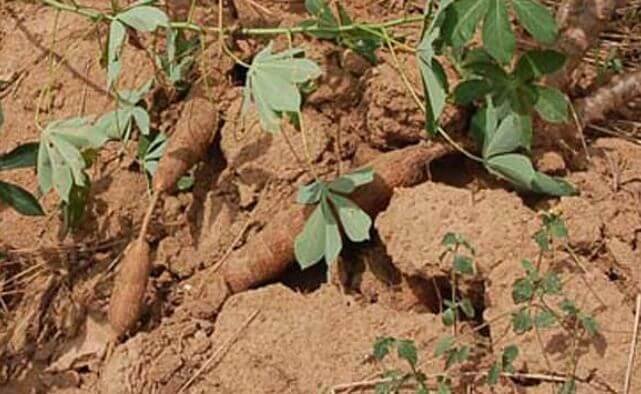
In addition to the above visual signs, identifying the right time to harvest cassava involves careful observation of several tactile signs.
Texture
Tactile signs are the physical texture, the sensory indicator that can be felt or touched.
The physical texture and firmness of the cassava roots add to knowing their readiness. To assess this, you should gently press the roots.
A firm and solid texture usually indicates that the roots have matured properly, as immature roots may feel soft and pliable.
It is important to evaluate multiple roots, as variations can occur within different plants in the same crop.
The Ease of Pulling
Another tactile sign is the ease with which the roots can be pulled or dug up. When cassava plants are ready for harvest, the roots will often come out of the ground with relative ease.
If roots resist being pulled or require excessive force to unearth, it is advisable to wait a little longer before attempting to harvest.
This resistance can signal that the roots have not yet reached their optimal size or quality.
Therefore, the act of gently tugging on the roots serves as an essential tactile check.
Related: Climate Impact on Cassava Farming
Inspecting the Surrounding Soil
Additionally, inspecting the surrounding soil can provide supplementary clues about the readiness of the cassava roots.
As a kid, how I usually knew the cassava was ready by the cracked soil around the cassava stem, especially in dry seasons. The mature roots will make the soil above it to crack and sometimes you can see the roots when you look closely.
Dry and loose soil often facilitates easier harvesting; hence, if conditions allow for effortless digging, it reflects well on the maturity of the cassava.
Harvesting at the optimal time is vital to ensure that the roots maintain their quality and flavor.
By paying attention to these tactile signs, you can increase the likelihood of a successful and bountiful cassava harvest, leading to high-quality roots that are suitable for various culinary uses.
Related: The Methods for Planting Cassava
Timing for Harvesting
As mentioned earlier, cassava is generally ready for harvest between 8 to 24 months after planting, depending on the specific variety cultivated.
For most cassava varieties, farmers should consider harvesting within this 8 to 12-month window to ensure a good balance between yield and quality.
Moreover, as the cassava plant matures, the roots continue to expand in size, and starch accumulation increases.
However, leaving the roots in the ground too long can lead to decreased quality due to the potential for physiological deterioration and increased susceptibility to pests and diseases.
Varieties with a longer maturation period can be harvested later, but it is vital to observe the specific characteristics of each type.
Signs such as yellowing leaves or peeling bark can indicate that the roots are mature and ready for harvesting.
Seasonal factors also significantly impact the timing for harvesting cassava. The best time to harvest typically coincides with dry seasons, as wet conditions can cause roots to decay and complicate harvesting logistics.
In regions experiencing consistent rainfall, it is advisable to wait until the weather stabilizes, allowing for soil conditions to improve.
Additionally, local climate variations, soil type, and overall environmental conditions should influence the decision-making process regarding cassava harvesting.
Understanding the interplay between these elements ensures that cassava growers optimize their harvest effectively, thereby securing better results from each planting cycle.
Related: Understanding the Cassava Hybrid
Consequences of Late Harvesting
When cassava roots are left in the ground beyond their ideal harvest window, several negative consequences can arise, impacting both the economic viability and culinary usability of the crop.
Degradation of Root Quality
The foremost immediate effect of late harvesting is the degradation of root quality. As cassava matures beyond its optimal point, the taste and texture begin to deteriorate.
Older roots can become fibrous and woody, making them less palatable for consumption.
Pest Infestation and Diseases
Moreover, late harvesting can lead to an increase in pest infestations and diseases.
As cassava roots remain in the ground for extended periods, they become more susceptible to attacks from pests such as cassava mealybugs and various nematodes.
These pests damage the roots and compromise their overall health and economic value.
Prolonged exposure to soil conditions can lead to root rot, a critical issue that arises when the soil is overly wet or when organic matter accumulates excessively.
Root rot can render the plant unharvestable, resulting in significant losses for farmers.
The overall yield derived from cassava can also be severely affected. When a farmer delays the harvest, they risk reducing their production volume due to root deterioration and pest damage.
The lost yield can affect income, especially for smallholder farmers who depend on cassava as a staple crop.
Farmers need to monitor cassava closely and adhere to optimal harvesting times to avoid these detrimental consequences, ensuring a healthy and profitable harvest.
Conclusion
Understanding when cassava is ready for harvest is important for farmers and gardeners to optimize production.
Key indicators include leaf maturity, plant health, and root size and texture.
Regularly monitoring these signs ensures better quality and maximizes yield potential.
Farmers should observe their crops closely, adapting harvesting strategies based on environmental factors and physiological states.
This proactive approach enhances harvesting practices and supports sustainable agriculture, contributing to cassava’s viability as a crucial crop worldwide.
By being vigilant and informed, farmers can significantly improve harvesting effectiveness, ensuring productivity and profitability year after year.
References:
- https://www.iita.org/wp-content/uploads/2016/06/Growing_cassava_in_Nigeria.pdf
- https://www.sei.org/publications/screening-cassava-maturity-market/
- https://www.tagrmfarming.com/news/harvesting-of-cassava-is-important-how-do-you-harvest-cassava-179311.html
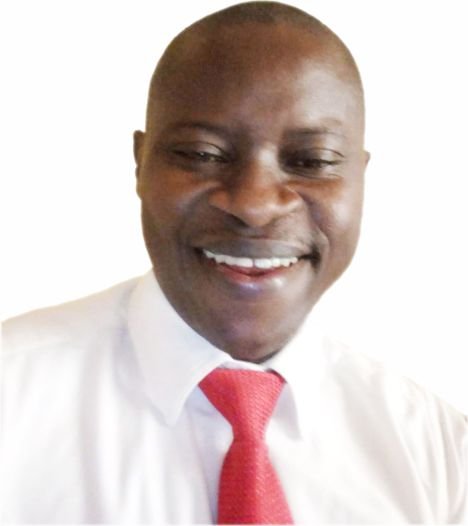
Chimeremeze Emeh is a writer and researcher passionate about Africa’s most transformative root crop—cassava. Through his work at cassavavaluechain.com, he explores the entire cassava industry, from cultivation and processing to its diverse applications in food, health, and industrial use.
He also writes for palmoilpalm.com, where he shares his extensive experience and deep-rooted knowledge of palm oil, covering red palm oil, palm kernel oil, and refined products. His work there reflects his lifelong connection to agriculture and his commitment to promoting sustainable value chains in Africa.
Driven by curiosity and purpose, Chimeremeze aims to shed light on how cassava continues to empower communities, strengthen food systems, and link traditional farming wisdom with modern innovation.
